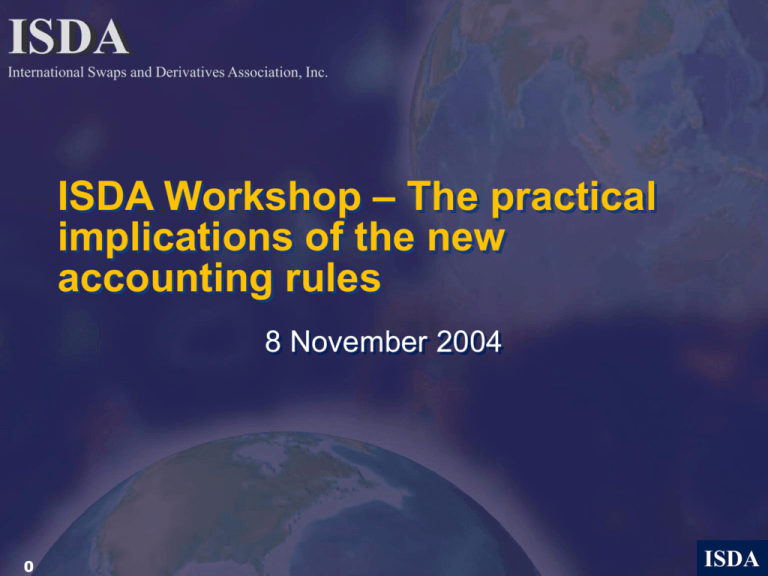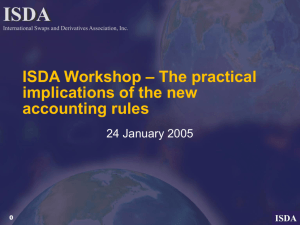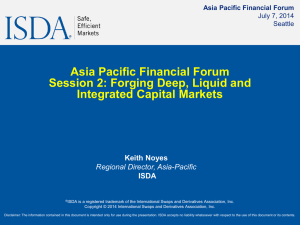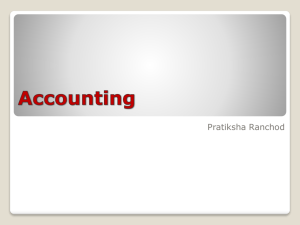Practical Impact of New Accounting Rules - International
advertisement

ISDA International Swaps and Derivatives Association, Inc. ISDA Workshop – The practical implications of the new accounting rules 8 November 2004 0 ISDA Overview of current position of IFRS • Significant differences between current UK GAAP and IFRS • Accounting for financial instruments under IFRS is rules based, UK GAAP is principles based • Adopted IFRS mandatory for all listed EU companies in their consolidated accounts after 1 January 2005 • Extension of IFRS to non-consolidated accounts varies by country • EU adopted IAS 39 will differ from that issued by the IASB. Certain “carve outs” have been proposed by the ARC • Changes still being proposed to IAS 39 with four Exposure Drafts issued since January 2004 1 ISDA IFRS – Key standards for financial instruments accounting IAS 39: - Recognition and measurement of financial assets and liabilities; - Treatment of certain other non-financial items eg, commodity contracts; - Derecognition of financial assets and liabilities IAS 32: - Presentation of financial instruments from the perspective of the issuer; - Provides detailed rules covering netting; - Requires disclosures to enable a user to understand significance of financial instruments to an entity’s financial position SIC 12: - Consolidation of Special Purpose Entities IFRS 4: - Insurance contracts IAS 37: - Provisions, contingent liabilities and contingent assets 2 ISDA The measurement categories Category Loans and receivables Held to maturity (HTM) Held at Fair Value Through Profit & Loss (FVTPL) to profit and loss Available for sale (AFS) Non-trading liabilities 3 Fair value to equity – unless impaired Cost / amortised cost At effective yield At effective yield Only if FV cannot be reliably measured (very limited – use only for unquoted equity instruments and derivatives thereon) ditto • IAS 39 includes an option to designate ANY financial instrument at fair value at inception • Detailed guidance also provided on separating embedded derivatives from host contracts ISDA Hedge Accounting - Key steps to achieving a qualifying hedge 1. Identify the type of hedge – fair value or cash flow or net investment 2. Identify the hedged item or transaction 3. Identify the nature of the risk being hedged 4. Identify the hedging instrument 5. Demonstrate that the hedge has and will continue to be highly effective 6. Document the hedging relationship above, including the risk management objectives and strategy for undertaking the hedge 7. Monitor effectiveness 4 ISDA Fair Value measurement • Defined as: “The amount for which an asset could be exchanged, or a liability settled, between knowledgeable, willing parties in an arms length transaction” • It is not the amount that an entity would receive or pay in a forced transaction or distressed sale • Active markets – defined as those where quoted prices are readily available and representative of actual, regular market transactions. Financial Instrument valued using quoted price • No active market – models that are commonly used by the market are considered appropriate for valuing financial instruments 5 ISDA Presentation – Netting & debt v equity • Financial liability – a contractual obligation to deliver cash or another financial asset to an entity • Equity instrument – a contract that evidences a residual interest in the assets of an entity • Some instruments have both a liability and equity component – eg convertible bonds. The fair value of the liability should be classified in the liability section of the balance sheet and the “plug” in equity • Ownership by an entity of its own shares is never an asset of that entity • Complex rules for derivatives on own shares • Financial assets and liabilities may only be offset in the balance sheet when there is both: - 6 a legal, enforceable right of set-off; and an intention to exercise the right or settle simultaneously ISDA Consolidation and Derecognition Consolidation Principles (SIC 12) • An enterprise should consolidate enterprises it controls • Control of SPEs is determined by considering factors outlined in SIC 12 Derecognition Principles (IAS 39) • Applied to transferor’s consolidated group, including SPEs if consolidated • Mixed model, based on both risks and rewards and control. Revised standard based on a decision tree: – Has there been a transfer or pass-through of cash flows? – Has there been a substantial change in the exposure to the risks and rewards? – Has there been a transfer of control (as evidenced by transferee’s ability to sell assets)? 7 ISDA











